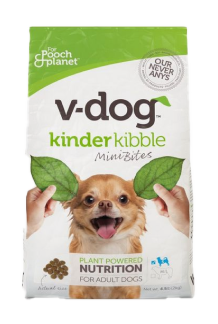
DogFoodAdvisor is reader supported See how
All reviews are 100% impartial but if you buy using links on this page, we may earn a referral fee.
V-Dog Kinder Kibble is a vegetarian product line made up of two dry dog foods. It is unrated by the Dog Food Advisor because our review methodology favors dog foods rich in meat, and judging a plant-based diet against this criteria would always give a low rating.
The V-Dog Kinder Kibble product line includes 2 dry dog foods.
Each recipe below includes its related AAFCO nutrient profile when available on the product’s official webpage: Growth, Maintenance, All Life Stages, Supplemental or Unspecified.
Important: Because many websites do not reliably specify which Growth or All Life Stages recipes are safe for large breed puppies, we do not include that data in this report. Be sure to check actual packaging for that information.
- V-Dog Kinder Kibble [M]
- V-Dog Kinder Kibble Mini Bites [M]
V-Dog Kinder Kibble was selected to represent both products in the line for this review.
V-Dog Kinder Kibble
Estimated Dry Matter Nutrient Content
Protein
Fat
CarbsCarbohydrates
Dried peas, pea protein, brown rice, oatmeal, potato protein, sorghum, canola oil (preserved with mixed tocopherols), natural flavor, suncured alfalfa meal, brewers dried yeast, dicalcium phosphate, flaxseeds, millet, calcium carbonate, lentils, peanut hearts, quinoa, sunflower chips, salt, potassium chloride, choline chloride, taurine, dried carrots, minerals (ferrous sulfate, zinc sulfate, copper sulfate, sodium selenite, manganese sulfate, calcium iodate), dl-methionine, dried parsley, vitamins (vitamin E supplement, vitamin A supplement, niacin supplement, d-calcium pantothenate, riboflavin supplement, vitamin D2 supplement, thiamine mononitrate, vitamin B12 supplement, pyridoxine hydrochloride, biotin, folic acid), l-ascorbyl-2-polyphosphate (a source of vitamin C), preserved with citric acid, preserved with mixed tocopherols, dried blueberries, dried cranberries, dried celery, Yucca schidigera extract, dried lettuce, l-carnitine, dried watercress, dried spinach, rosemary extract
Fiber (estimated dry matter content) = 5%
Red denotes any controversial items
| Estimated Nutrient Content | |||
|---|---|---|---|
| Method | Protein | Fat | Carbs |
| Guaranteed Analysis | 24% | 9% | NA |
| Dry Matter Basis | 27% | 10% | 55% |
| Calorie Weighted Basis | 25% | 23% | 52% |
The first ingredient in this dog food lists dried peas. Dried peas are a good source of carbohydrates. Plus they’re naturally rich in dietary fiber.
However, dried peas contain about 27% protein, a factor that must be considered when judging the meat content of this dog food.
The second ingredient is pea protein, what remains of a pea after removing the starchy part of the vegetable.
Even though it contains over 80% protein, this ingredient would be expected to have a lower biological value than meat.
And less costly plant-based products like this can notably boost the total protein reported on the label — a factor that must be considered when judging the meat content of this dog food.
The third ingredient is brown rice, a complex carbohydrate that (once cooked) can be fairly easy to digest. However, aside from its natural energy content, rice is of only modest nutritional value to a dog.
The fourth ingredient is oatmeal, a whole-grain product made from coarsely ground oats. Oatmeal is naturally rich in B-vitamins, dietary fiber and can be (depending upon its level of purity) gluten-free.
The fifth ingredient is potato protein, the dry residue remaining after removing the starchy part of a potato.
Even though it contains over 80% protein, this ingredient would be expected to have a lower biological value than meat.
And less costly plant-based products like this can notably boost the total protein reported on the label — a factor that must be considered when judging the actual meat content of this dog food.
The sixth ingredient is sorghum. Sorghum (milo) is a starchy cereal grain with a nutrient profile similar to corn.
Since it is gluten-free and boasts a smoother blood sugar behavior than other grains, sorghum may be considered an acceptable non-meat ingredient.
The seventh ingredient is canola oil. Unfortunately, canola can be a controversial item. That’s because it can sometimes (but not always) be derived from genetically modified rapeseed.
Yet others cite the fact that canola oil can be a significant source of essential omega-3 fatty acids.
In any case, plant-based oils like canola are less biologically available to a dog than fish oil as a source of quality omega-3 fats.
After the natural flavor, we find alfalfa meal. Although alfalfa meal is high in plant protein (about 18%) and fiber (25%), this hay-family item is more commonly associated with horse feeds.
From here, the list goes on to include a number of other items.
But to be realistic, ingredients located this far down the list (other than nutritional supplements) are not likely to affect the overall rating of this product.
With five notable exceptions…
First, brewers yeast can be a controversial item. Although it’s a by-product of the beer making process, this ingredient is rich in minerals and other healthy nutrients.
Fans believe yeast repels fleas and supports the immune system.
Critics argue yeast ingredients can be linked to allergies. This may be true, but (like all allergies) only if your particular dog is allergic to the yeast itself.
In addition, a vocal minority insists yeast can increase the risk of developing the life-threatening condition known as bloat. However, this is a claim we’ve not been able to scientifically verify.
In any case, unless your dog is specifically allergic to it, yeast can still be considered a nutritious additive.
What’s more noteworthy here is that brewers yeast contains about 48% protein, a factor that must be considered when judging the actual meat content of this dog food.
Next, flaxseed is one of the best plant sources of healthy omega-3 fatty acids. Provided they’ve first been ground into a meal, flax seeds are also rich in soluble fiber.
However, flaxseed contains about 19% protein, a factor that must be considered when judging the actual meat content of this dog food.
In addition, we find lentils. Lentils are a quality source of carbohydrates. Plus (like all legumes) they’re rich in natural fiber.
However, lentils contain about 25% protein, a factor that must be considered when judging the actual meat content of this dog food.
Next, we find no mention of probiotics, friendly bacteria applied to the surface of the kibble after processing to help with digestion.
And lastly, the minerals listed here do not appear to be chelated. And that can make them more difficult to absorb. Chelated minerals are usually associated with higher quality dog foods.
V-Dog Kinder Kibble Dog Food Review
V-Dog is by design a meatless product.
So, although we recognize the need for some dog owners to feed a meat-free diet, we also respect a dog’s natural carnivorous bias.
The dashboard displays a dry matter protein reading of 27%, a fat level of 10% and estimated carbohydrates of about 55%.
And a fat-to-protein ratio of about 38%.
Near-average protein. Below-average fat. And above-average carbs when compared to a typical dry dog food.
Bottom line?
V-Dog is a meatless, grain-inclusive dry dog food that uses pea and potato proteins as its main source of protein.
V-Dog Dog Food Recall History
The following list (if present) includes all dog food recalls since 2009 directly related to V-Dog. If there are no recalls listed in this section, we have not yet reported any events.
You can view a complete list of all dog food recalls sorted by date. Or view the same list sorted alphabetically by brand.
More Choices
Readers interested in V-Dog Kinder Kibble dog food may also wish to check out these popular pages, too…
Notes and Updates
Compare This Dog Food
How does this brand compare with The Dog Food Advisor's most recommended brands?
A Final Word
The Dog Food Advisor does not accept money, gifts, samples or other incentives in exchange for special consideration in preparing our reviews.
However, we do receive a referral fee from online retailers (like Chewy or Amazon) and from sellers of perishable pet food when readers click over to their websites from ours. This helps cover the cost of operation of our free blog. Thanks for your support.
For more information, please visit our Disclaimer and Disclosure page.







